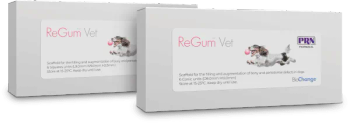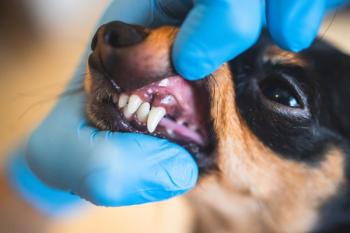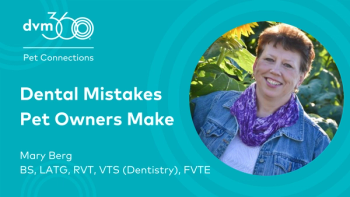
Intraoral radiology (Proceedings)
The cornerstone of veterinary dentistry is visualization of disease.
The cornerstone of veterinary dentistry is visualization of disease. This accomplished by:
1) inspection
2) surgical exposure
3) dental radiology.
Inspection is best performed with magnification using 3 to 5 power loops. Surgical exposure is done with a # 15c scalpel and molt periosteal elevator. Radiology is done with intraoral high detail dental film. Radiology is as important in dentistry as it is in other medical disciplines. Without radiology, the veterinary dentist is attempting to operate blindfolded.
Equipment
The single most important item is intraoral dental film. While there are a multitude of sizes and shapes the sizes most suited for veterinary dentistry are the "occlusal" at 54 x 70 and the standard "periapical" at 30 x 40. The speed film most veterinarians use is "D" to allow its use in chairside developers. The author prefers Kodak size 4 DF-50 Occlusal Ultraspeed and size 2 DF-58 Periapical Ultraspeed dental x-ray film. Other sizes are available and because of the inexpensive nature of dental x-ray film other film sizes should be tried to allow the veterinarian to maximize their knowledge base.
Developing dental films can be accomplished by:
1) existing conventional darkroom tanks
2) piggybacking on standard film through automatic processors
3) automatic chairside developers
4) manual chairside developers.
Clearly the most cost efficient way to develop dental films is with a chairside developer. Cost is about $250.00 Results are attained within 60 seconds using Rapid Processing chemistries. The chairside unit is totally mobile and does not require a dark room. A modification can be made to the system to allow use of the occlusal films without the hassles of cramming a large film in a small container. A dark plastic base is cut to size by any glass company. Cost is about $15.00. Three 2 ½ cup containers are purchased from the local medical supply company — Target, Meijers, or K Mart. Velcro strips are placed on the bottoms of the containers to keep them in place and the unit is ready. Incidental equipment such as film clips, film drying racks, filing are available at minimal cost.
Exposure of the films in best accomplished in an anesthetized animal ( perhaps the only shortcoming.) Therefore dental radiology is an interoperative procedure. While standard screen radiographs might be useful as a "scout film" they are inadequate for oral diagnosis.
The best source of radiation is from a dedicated intraloral dental xray unit. These units range in cost from "free to a good home" to $4000.00. A reasonable range is $2500 to $3500 for a new unit. The advantage of a new unit is that it is most likely to meet all safety standards. Most used units are available because they are being replaced with "legal" units. However, with care used units can be found that satisfy current safety standards. The author recommends finding units with the longest reach possible. It is usually easier to move the xray head than the animal's head so the greatest flexibility possible in the dental unit is desired. As with any equipment, service after the sale is important and should be considered when purchasing a dental radiology unit.
Existing radiology equipment in a veterinary hospital can be and should be used if a dedicated dental unit is not available. Most standard machines will work well by shortening the focal film distance to 20 cm and using:
small dogs and cats: 60-70 kVp, 20 mA at .5 to .8 seconds
medium and large dogs: 65 - 75 kVp, 20 mA at .8 to 1 second
Since all xray machines and geographic line voltages vary a little trial and error is used to develop a technique chart. Because the periapical film is so inexpensive this should not represent an economic burden to the practice.
Digital radiology is the next step in the evolution of intraoral radiology. The advantage is speed of processing and minimal if any maintenance costs. Dental film, chemistries, and storage are eliminated. Storage is done on the "hard drive." Software programs allow manipulation of the films, reverse contrasting, colorization, and e-mailing to a specialist. In fact, digital radiology in general will displace film based radiology much like the printed film industry. The factors to consider when purchasing digital equipment are the size of imaging films available and technical support from the company. Products like the EVA system are limited to periapical size 2 films. Products like the Scan X system range from size 0 to 10 x 12 films. Once a practice invests in a digital system the question is always "why didn't we do this sooner?"
Positioning
Two basic techniques are used in veterinary dentistry:
1) parallel
2) bisecting angle.
Both of these techniques are discussed in detail in Handbook of Small Animal Dentistry by Emily and Penman (Pergamon Press) and Small Animal Dentistry by Harvey and Emily (Mosby). Both of these texts have excellent descriptions and illustrations.
In general, the parallel technique involves placing the xray film parallel to the long axis of the tooth to be radiographed and exposing the film to radiation. This is usually limited to the posterior mandible in dogs since the hard palate is not vaulted. In the feline species the parallel technique has limited application.
The bisecting angle is commonly the most used technique in veterinary dentistry. It involves a little geometry (remember those math classes in high school and college that we all though were useless?) and thinking in three dimensions. With a little practice it is no more difficult to do than positioning a dog for OFA films.
The bisecting angle is that line that equally divides the plane of the x-ray film and the plane of the long axis of the tooth to be x-rayed. The x-ray film is directed perpendicular to this line. The geometry involves making two equilateral triangles using the x-ray film and tooth root as the x and y axis and the bisecting angle line as the common line that divides the large triangle into two equal halves. The good news is that this technique is very forgiving and for most situations small amounts of foreshortening or elongation are not clinically significant. If positioning problems occur a little trial and error is in order and films are repeated until diagnostic films are achieved (as in OAF positioning).
Other techniques used occasionally include extraoral positioning. This is useful when it is impossible to place a film intraorally or sometimes simply by personal preference. The limitations include superimposition of the contralateral structures. Both parallel and bisecting angle techniques are utilized.
Applications
The nondental uses of high detail dental film include:
- evaluation of extremities of small animals, especially cats
- exotics, especially pockets pets, birds, snakes, rats, frogs, etc.
- nasal disease, especially tumors
- margin evaluation post op of hard tissue
The uses of dental film include:
- periodontic disease evaluation
- endodontic disease evaluation
- interoperative endodontic disease (mandatory)
- orthodontic
- retained roots, both pathologic and iatrogenic
- tooth structure evaluation (especially feline odontoclastic resporptive lesions)
- trauma (maxillary and mandibular fractures)
- neoplasia, both soft tissue and hard tissue
Interpretation
Reading dental films is dependent on the veterinarians willingness to understand normal anatomy. Many films of normal animals should be taken and studied to properly understand the diseased state. Positional artifacts can be identified if a skull is available to visualize hard tissue anatomy that may be superimposing the study area. Various foramen can be confused with pathology so knowing their location and relationship to teeth apices is important. Misinterpretation of an apical lesion can lead to an unnecessary endodontic treatment. If skulls are not available standard veterinary anatomy books will help identify potential misinterpretation areas. In a sentence "know normal anatomy!"
Newsletter
From exam room tips to practice management insights, get trusted veterinary news delivered straight to your inbox—subscribe to dvm360.






